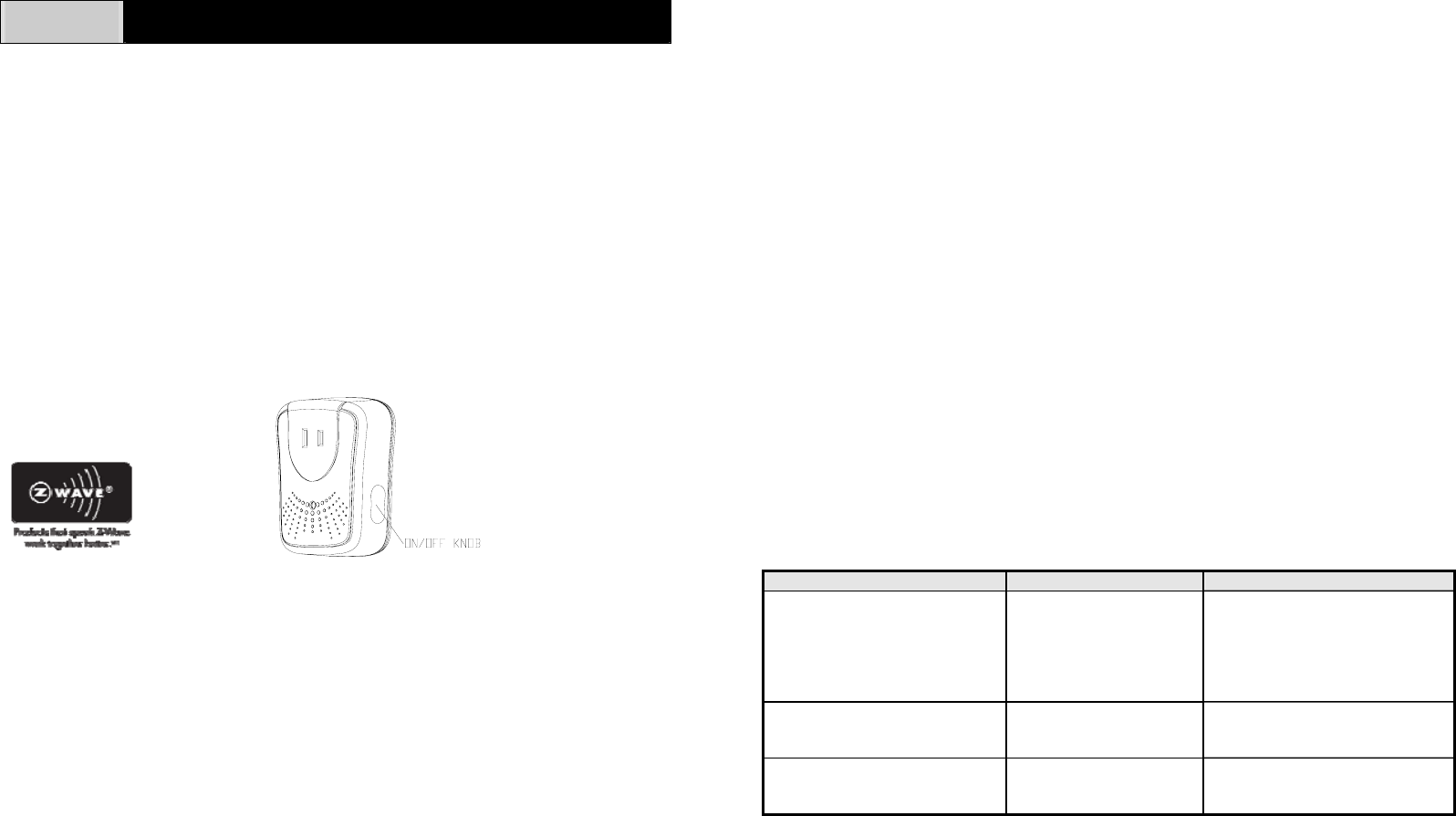Everspring Industry Co AN135 Wireless Alarm System 908.42MHz User Manual
Everspring Industry Co Ltd Wireless Alarm System 908.42MHz
Users Manual

1
AN135 ON/OFF MODULE
This plug-in On/Off Module is designed to work with our Passive Infrared Detectors
SP103 and Door/Window Detectors SM103, serving as a receiver. The AN135
plug-in On/Off Module is a Z-WaveTM enabled device and is fully compatible with
any Z-WaveTM enabled network. Z-WaveTM enabled devices displaying the
Z-WaveTM logo can also be used with it regardless of the manufacturer, and ours
can also be used in other manufacturer’s Z-WaveTM enabled networks. Remote
On/Off control of the connected load is possible with other manufacturer’s Wireless
Controller.
Adding to Z-WaveTM Network
In the side of the casing, there is an On/Off knob which is used to carry out
inclusion, exclusion or association. Put a Z-WaveTM Wireless Controller into
inclusion/exclusion mode, press the knob on the module to complete the
inclusion/exclusion process.
Fig. 1
Installation
1. Plug this On/Off module into a wall outlet near the load to be controlled.
2. Plug the load into the On/Off module. Make sure the load to be controlled
cannot exceed 700 watts.
3. Turn the knob or switch on the load to the ON position.
4. To manually turn ON the AN135 On/Off Module, press and release the On/Off
knob. The red indicator LED will turn ON, and the load plugged into the AN135
On/Off module will also turn ON.
5. To manually turn OFF the AN135 On/Off Module, simply press and release the
On/Off knob. The red indicator LED will turn OFF and the load plugged into the
AN135 On/Off Module will also turn OFF.
6. If Passive Infrared Detector SP103 or Door/Window Detector SM103 has been
removed from the wall by triggering the tamper switch, the Detector (SP103 or
SM103) will send an alarm command (ALARM_REPORT, Alarm Type ==
0x01, Alarm Level == 0x11) to the AN135 On/Off Module, of which red
indicator LED and the load plugged into the AN135 On/Off module will be on
and off intermittently for 10 seconds simultaneously.
Note: When putting Passive Infrared Detector or Door/Window Detector in use,
do not connect the load belongs to motor or electronic transformers, as the
load would be impaired.
Programming
The On/Off knob allows the user
- Turn on or off the load attached
- Include or exclude the module from the Z-WaveTM system
- Control other Z-WaveTM enabled devices
See the instructions for SP103 Passive Infrared Detector or SM103 Door/Window
Detector.
Troubleshooting
Symptom Cause of Failure Recommendation
The Module not working and
LED off 1. The Module is not
plugged into the
electrical outlet
properly
2. The Module is out of
order
1. Check power connections
2. Don’t open up the Module and
send it for repair.
The Module LED illuminating,
but cannot control the ON/OFF
Switch of the load attached
Check if the load plugged
into the Module has its
own ON/OFF switch
Set the ON/OFF switch of the
load attached to ON
The Module LED illuminating,
but the Detector cannot control
the Module
1. Not carry out
association
2. Frequency interference
1. Carry out association
2. Wait for a while to re-try
Specification

2
Operating Voltage 120V/60Hz
Maximum Load 600W
Range Minimum 100 feet line of sight
Frequency Range 908.42 MHz
** Specifications are subject to change and improvement without notice. A501110876R
Mobile of end product
Federal Communication Commission Interference Statement
This equipment has been tested and found to comply with the limits for a
Class B digital device, pursuant to Part 15 of the FCC Rules. These limits
are designed to provide reasonable protection against harmful interference
in a residential installation. This equipment generates, uses and can
radiate radio frequency energy and, if not installed and used in accordance
with the instructions, may cause harmful interference to radio
communications. However, there is no guarantee that interference will
not occur in a particular installation. If this equipment does cause harmful
interference to radio or television reception, which can be determined by
turning the equipment off and on, the user is encouraged to try to correct
the interference by one of the following measures:
- Reorient or relocate the receiving antenna.
- Increase the separation between the equipment and receiver.
- Connect the equipment into an outlet on a circuit different from that to
which the receiver is connected.
- Consult the dealer or an experienced radio/TV technician for help.
This device complies with Part 15 of the FCC Rules. Operation is subject
to the following two conditions: (1) This device may not cause harmful
interference, and (2) this device must accept any interference received,
including interference that may cause undesired operation.
FCC Caution: Any changes or modifications not expressly approved by the
party responsible for compliance could void the user's authority to operate
this equipment.
IMPORTANT NOTE:
This transmitter must not be co-located or operating in conjunction with
any other antenna or transmitter.